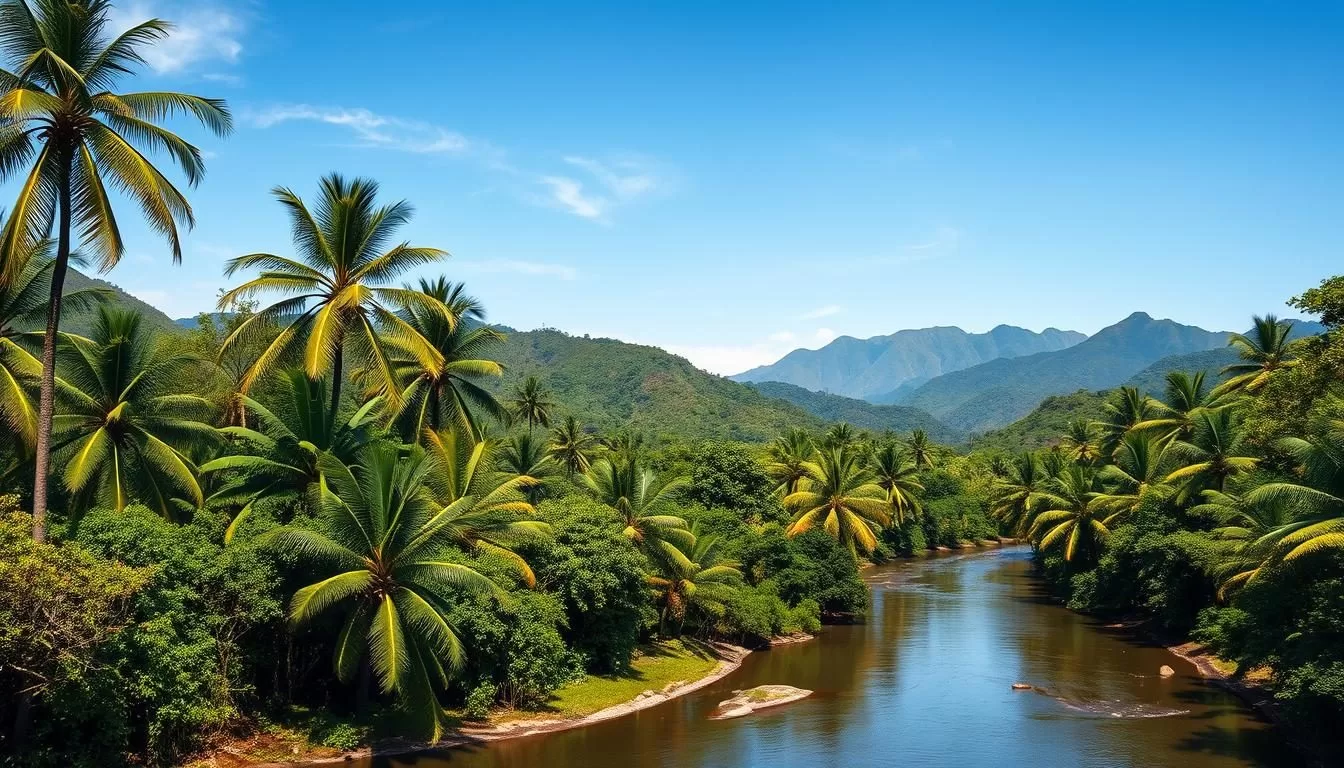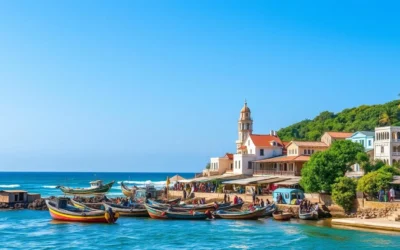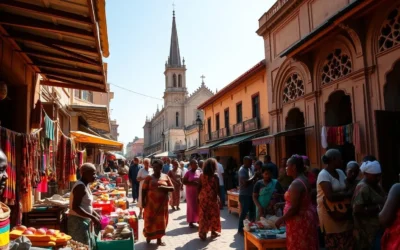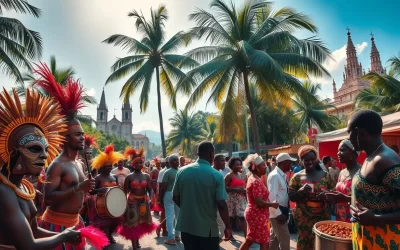✓ Accommodations ✓ Flights ✓ Rental Cars
Planning a trip to Ivory Coast requires more than just choosing a destination; it demands timing your visit perfectly to make the most of your travel experience.
Located on the coast of the Gulf of Guinea, Ivory Coast is a vibrant West African nation boasting diverse landscapes, from pristine beaches to lush rainforests. With over 60 languages spoken across the country, its rich cultural heritage is undeniable.
Understanding Ivory Coast’s tropical climate is crucial. The country’s seasonal patterns significantly impact your travel experience, making some times of the year more favorable than others for exploring its UNESCO World Heritage sites, vibrant festivals, and wildlife-rich national parks.
By determining the ideal time to visit based on your preferences and planned activities, you can ensure a memorable and enjoyable trip to this diverse and captivating country.
Understanding Ivory Coast’s Climate Patterns
The tropical climate of Ivory Coast is marked by distinct wet and dry seasons, a characteristic shaped by the African monsoon. This climate pattern significantly influences the country’s weather conditions throughout the year.
Tropical Climate Overview
Ivory Coast experiences a tropical climate with a dry season from December to February and a rainy season from April to October. The African monsoon drives these seasonal changes, bringing significant rainfall to the region. Along the coast, the rains are substantial in March and November, and even in December on the westernmost part. The country’s climate is characterized by high temperatures, ranging from 25°C to 32°C (77°F to 90°F) throughout the year.
The rainfall in Ivory Coast varies greatly between the coastal and inland areas. Coastal regions receive between 1,500 and 2,500 millimeters (60 and 100 inches) of rainfall per year, while inland areas generally receive less, ranging from 1,200 to 1,500 mm (47 to 60 in) per year.

Regional Weather Variations
Regional variations in climate are notable across Ivory Coast. The coastal areas experience a humid tropical climate due to their proximity to the Gulf of Guinea. In contrast, inland areas have slightly different weather patterns, with the northern regions being drier than the coastal areas. The western mountainous region has a unique microclimate, receiving up to 2,000 mm (80 in) of rainfall annually.
Understanding these regional variations is crucial for planning a visit to Ivory Coast. The country’s diverse climate patterns mean that the best time to visit Ivory Coast depends on the region you plan to explore. Whether you’re heading to the coastal areas or venturing inland, being aware of the local climate conditions will enhance your travel experience.
The Dry Season: November to March
November to March is the perfect time to discover Ivory Coast, as the dry season brings pleasant weather conditions. During this period, you can enjoy clear skies and comfortable temperatures, making it ideal for outdoor activities and exploration.

Weather Characteristics
The dry season in Ivory Coast is characterized by minimal rainfall and pleasant temperatures ranging from 25°C to 32°C (77°F to 90°F). The humidity is significantly lower compared to the wet season, creating a comfortable atmosphere for travelers. You can expect plenty of sunshine, making it perfect for visiting the beautiful beaches, national parks, and cultural sites.
Advantages for Travelers
Traveling to Ivory Coast during the dry season offers several advantages. The dry conditions make road travel easier, allowing you to explore rural areas without the hindrance of rain. Additionally, the dry season is ideal for wildlife viewing in national parks, as animals tend to congregate around water sources, making them easier to spot. You can also enjoy outdoor activities like hiking and beach trips without weather disruptions.
Potential Drawbacks
While the dry season is considered the best time to visit Ivory Coast, there are some potential drawbacks to be aware of. The harmattan winds can bring dusty conditions to the northern parts of the country, which might be uncomfortable for some travelers. Furthermore, the dry season is peak tourist season, which means popular destinations may be more crowded, and prices for accommodations might be higher.
The Rainy Season: April to October
The rainy season in Ivory Coast, spanning from April to October, is characterized by higher temperatures, increased humidity, and frequent rainfall. This period brings both challenges and opportunities for travelers, making it essential to understand its implications for a well-planned trip.

Rainfall Patterns and Intensity
Ivory Coast experiences varied rainfall patterns across different regions during the rainy season. The coastal areas receive significant rainfall, with some regions getting up to 2,500mm annually. In contrast, the northern parts of the country experience less precipitation, even during the wet months. Understanding these patterns is crucial for planning your itinerary and making the most of your visit.
Key rainfall characteristics include:
- High levels of rainfall in coastal regions
- Varied intensity across different areas
- Impact on regional accessibility and activities
Travel Considerations During Wet Months
Traveling during the rainy season requires careful planning and flexibility. While the rains can make some areas difficult to access, they also bring the country to life, offering lush landscapes and vibrant scenery. It’s essential to be aware of the potential challenges, including road closures and increased risk of malaria, and to plan accordingly.
Consider the following when traveling during the rainy season:
- Potential road closures and limited access to certain attractions
- Increased risk of malaria due to higher mosquito populations
- Lower travel costs and fewer tourists
- Lush, vibrant landscapes and the opportunity to witness spectacular thunderstorms
By understanding the rainfall patterns and being prepared for the challenges, you can have a rewarding experience visiting Ivory Coast during the rainy season.
Best Months to Visit Ivory Coast

The best months to visit Ivory Coast are influenced by its dry and rainy seasons. Understanding these seasons is crucial for planning a trip that meets your preferences and itinerary.
November to December: Early Dry Season Benefits
November and December mark the beginning of the dry season in Ivory Coast, offering several benefits for travelers. The temperatures are comfortable, and the rainfall decreases significantly, making it an ideal time for outdoor activities like exploring national parks and visiting the beautiful beaches.
During these months, you can enjoy fewer tourists compared to the peak season, allowing for a more relaxed experience at popular destinations. The early dry season also provides a great opportunity to witness the country’s natural beauty without the crowds.
January to March: Peak Travel Season
The period from January to March is considered the peak travel season in Ivory Coast. The weather conditions are at their most reliable, with minimal rainfall and moderate temperatures throughout most of the country. This makes it an ideal time for activities such as hiking, wildlife viewing, and beach relaxation.
Travelers can also experience the vibrant culture of Ivory Coast during this period, with various festivals and events taking place. However, it’s worth noting that this is the busiest time of the year, and popular destinations may be more crowded.
Whether you choose to visit during the early dry season or the peak travel season, Ivory Coast offers a unique and enriching experience. By understanding the advantages of each period, you can plan your trip to make the most of your time in this beautiful country.
Regional Guide: Where to Go When
The diverse regions of Ivory Coast, from coastal areas to northern savannahs, have unique weather patterns that affect the best times to visit. Understanding these regional variations is key to planning a well-rounded trip.
Coastal Areas and Beaches
The coastal regions, including popular destinations like Grand-Bassam and Assinie, are known for their beautiful beaches. The best time to visit these areas is during the dry season, from November to March, when the weather is dry and sunny, ideal for beach activities and water sports. The coastal climate is generally warm, but the dry season brings more comfortable temperatures.
Central Plateaus and Cities
Abidjan, the economic capital, and Yamoussoukro, the political capital, are located in the central plateaus. These cities offer a blend of modern infrastructure and cultural experiences. The dry season is the best time to visit these cities as the weather is more conducive for sightseeing and outdoor activities. You can explore attractions like the Plateau district, St. Paul’s Cathedral, and the vibrant markets of Treichville comfortably during this time.
Northern Savannah Regions
The northern savannah regions have a different climate compared to the south. The best time to visit these areas is during the dry season, before the harmattan winds bring dusty conditions. This period allows for comfortable exploration of the savannah landscapes and wildlife viewing. Visiting national parks during this time can be particularly rewarding.
By understanding the regional weather patterns, you can plan your trip to Ivory Coast to make the most of your visit, whether you’re interested in beaches, city life, or wildlife.
Month-by-Month Weather Breakdown
To plan your trip to Ivory Coast effectively, it’s crucial to examine the weather patterns throughout the year. This detailed breakdown will help you understand the temperature and rainfall averages, as well as the seasonal events and festivals that take place across different months.
Temperature and Rainfall Averages
Ivory Coast experiences a diverse range of weather conditions throughout the year. During the dry season, from November to March, temperatures are generally comfortable, ranging from 24°C to 32°C (75°F to 90°F) across different regions. January is particularly pleasant, with minimal rainfall and average temperatures around 27°C (81°F) in the southern coastal areas.
In contrast, the rainy season, which spans from April to October, brings significant rainfall, with the most substantial downpours occurring in June and July. Temperatures during this period remain relatively warm, often reaching highs of 30°C to 35°C (86°F to 95°F) in the northern savannah regions.
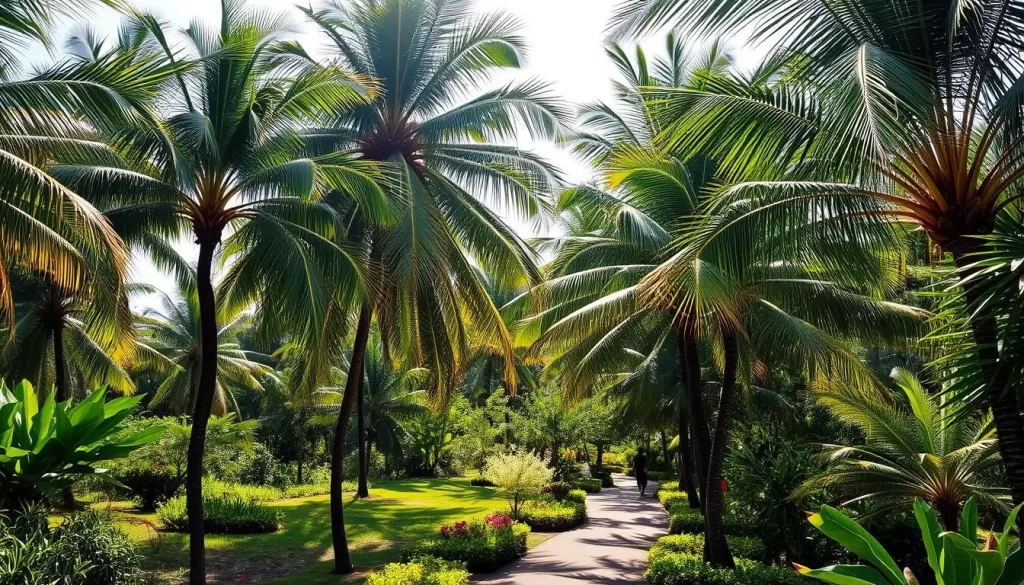
Seasonal Events and Festivals
Ivory Coast is known for its vibrant cultural scene, with numerous festivals and events taking place throughout the year. January, being part of the dry season, is an excellent time to experience the local culture, with events like the Fêtes des Masques in Man and the Bouaké Carnival showcasing traditional music, dance, and colorful costumes.
As the year progresses, other significant cultural celebrations include the Festival des Masques in April and various harvest festivals during the summer months. These events offer a unique opportunity to immerse yourself in the local culture and experience the rich heritage of Ivory Coast.
By understanding the month-by-month weather breakdown and the timing of these cultural events, you can plan your visit to Ivory Coast to coincide with the activities that interest you most.
Weather-Based Activities in Ivory Coast
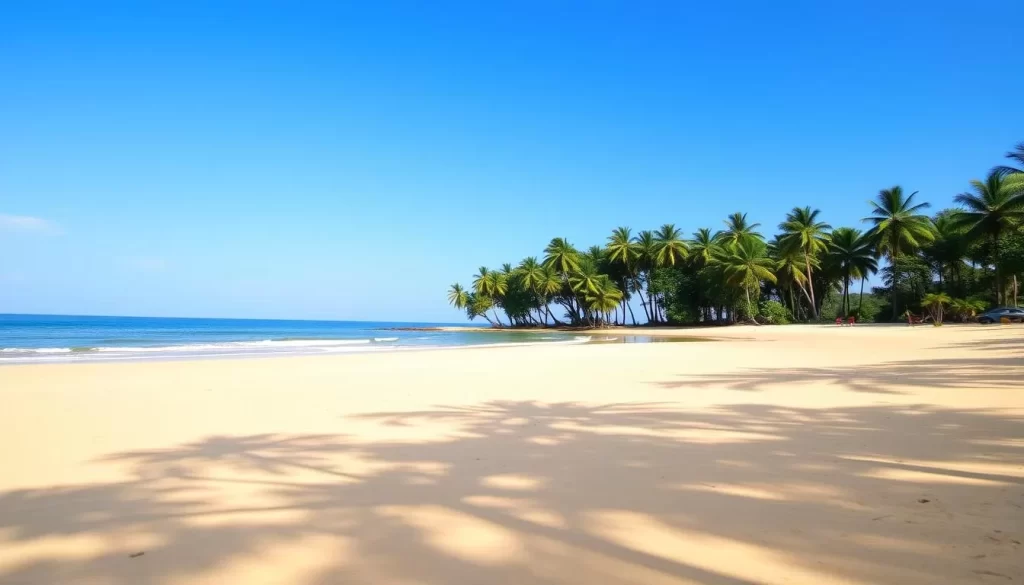
Ivory Coast’s climate and geography combine to create a rich tapestry of experiences for visitors. The country’s diverse regions offer a range of activities that are influenced by the seasonal weather patterns.
Dry Season Activities
During the dry season, from November to March, Ivory Coast is ideal for outdoor activities. You can explore the national parks like Taï and Comoé, which are teeming with wildlife during this period. The dry conditions make hiking in the western mountains more accessible, offering breathtaking views. Ivory Coast’s beautiful beaches, such as Monogaga Beach and Assinie Beach, are perfect for relaxation and water activities like swimming and surfing.
The dry season is also an excellent time for visiting Ivory Coast’s coastal areas, where you can enjoy boating and other water sports. The comfortable temperatures and lack of rainfall make it an ideal time to engage in various activities that allow you to appreciate the country’s nature.
Rainy Season Opportunities
While the rainy season might seem less appealing, it brings its own unique opportunities. The lush landscapes created by the rainfall offer excellent conditions for photography. With fewer tourists, major attractions are less crowded, allowing for a more serene experience. The rainy season also brings special natural phenomena that can only be witnessed during this time, making it a great period for nature enthusiasts to visit Ivory Coast.
Additionally, the rainy season is a good time for certain water-based activities, as the increased water flow can make certain surfing spots more appealing. Understanding the seasonal variations allows you to plan your activities accordingly and make the most of your visit.
Practical Travel Tips for Weather-Savvy Visitors
A weather-savvy approach is essential for enjoying all that Ivory Coast has to offer. Whether you’re visiting during the dry season or the rainy months, being prepared can make a significant difference in your travel experience.
What to Pack Based on Season
Packing appropriately for your trip to Ivory Coast is crucial. During the dry season, from November to March, you’ll want to bring lightweight, breathable clothing to protect yourself from the sun and heat. Don’t forget a hat, sunglasses, and sunscreen for added protection.
In contrast, the rainy season, which spans from April to October, requires waterproof gear and quick-drying clothing. It’s also wise to pack insect repellent to protect against mosquitoes and other insects that may be more prevalent during this time.
| Season | Clothing Recommendations | Additional Items |
|---|---|---|
| Dry Season (Nov – Mar) | Lightweight, breathable clothing | Hat, sunglasses, sunscreen |
| Rainy Season (Apr – Oct) | Waterproof gear, quick-drying clothing | Insect repellent |
Health and Safety Considerations
Before traveling to Ivory Coast, it’s advisable to visit a travel clinic to discuss vaccinations and malaria prevention. Yellow fever vaccination is particularly important, as it is a requirement for entry into the country.
To stay safe, be mindful of your surroundings, especially during the rainy season when flash floods can occur. Always have a contingency plan and stay informed about local weather conditions.
By being prepared and staying informed, you can have a safe and enjoyable trip to Ivory Coast, regardless of the time of year you visit.
Conclusion
Embarking on a journey to Ivory Coast requires insight into its climate to maximize your travel experience. By understanding the country’s diverse climate patterns, you can plan your trip during the best time of the year for your interests.
This guide has equipped you with the knowledge to make informed decisions about your visit, whether you’re drawn to the country’s nature, culture, or a mix of both. With this information, you’re ready to plan a trip to this vibrant destination and enjoy all it has to offer.
The above is subject to change.
Check back often to TRAVEL.COM for the latest travel tips and deals.
